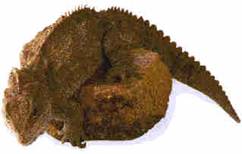Tuatara
|
|
| Tuatara | ||||||||||||
|---|---|---|---|---|---|---|---|---|---|---|---|---|
 A tuatara on a rock | ||||||||||||
| Scientific classification | ||||||||||||
| ||||||||||||
| Species | ||||||||||||
|
Sphenodon punctatus |
The tuatara is the only surviving member of Rhynchocephalia, or Sphenodontia/Sphenodontida (for more on this, see classification). Tuatara are endemic to New Zealand, and now live only on a small number of offshore islands. It has been classified as an endangered species since 1895. Tuatara, like many native New Zealand animals, are threatened by habitat loss, harvesting, and introduced species such as mustelids and rats.
| Contents |
Classification
Though tuatara resemble lizards, the genus has several characteristics unique among reptiles. Its teeth are fused to its jaw bone; it has no external copulatory organs or earholes. Indeed, tuatara were originally classified as lizards in 1831 when the British Museum received a skull. The species remained misclassified until 1867, when Gunther (also at the British Museum) noted certain bird-like, turtle-like, and crocodile-like features and proposed the order Rhynchocephalia (beak heads) for the tuatara and its fossile relatives.
Unfortunately, during the years since Gunther's inception of the rhynchocephalia, many disparately related species (including the similarly named archosaurian rhynchosaurs) have come to be added to this order. This has resulted in turning the rhynchocephalia into what taxonomists call a Wastebin taxon. Nowadays, most authors prefer to use the more inclusive order name of Sphenodontia for the tuatara and their closest living relatives. Sphenodontia was proposed by Williston in 1925, and thus has priority use over the similarly named Sphenodontida, which was proposed by Estes in 1983 (Fraser & Sues, 1994)
The Living Fossil Myth
Tuatara and sphenodontians in general (along with sharks and crocodylians) have been referred to as living fossils. This, essentially, meant that these animals remained unchanged throughout their entire tenure on this planet (~200 million years, for sphenodontians). Recent taxonomic work on Sphenodontia (Wu, 1994) has shown that this group has undergone a variety of changes throughout the Mesozoic. Many of the niches normally associated with lizards, were instead held by sphenodontians. There was even a successful group of aquatic sphenodontians known as pleurosaurs, which differed markedly from living tuatara.
Tuatara also show cold weather adaptations that allow them to thrive on the islands of New Zealand. These adaptations are probably unique to tuataras and not inherited from previous sphenodontians (which lived in much warmer climates).
Species
There are two extant species: Sphenodon punctatus and the much rarer Sphenodon guntheri, or Brothers Island tuatara, which is confined to The Brothers Islands in Cook Strait. These have olive skin with yellowish patches.
Name
The name tuatara derives from the Māori language, meaning "spiny back". Tuatara feature in a number of indigenous legends. They are held as ariki (God forms). Tuatara are regarded as the messengers of Whiro, the god of death and disaster. Māori women are forbidden to eat tuatara.
Natural History
Tuatara thrive in much lower temperatures than are tolerated by most reptiles, preferring temperatures of 16–21°C (60–70°F); temperatures over 27°C (80°F) are fatal. Adults are about 500 mm long and weigh between 0.5 and 1 kg. Tuatara are notoriously cryptic(?), and hibernate in winter. Adults are terrestrial and nocturnal, but hatchlings are arboreal and diurnal (likely because the adults are known to eat younger tuatara).
Tuatara are extremely long-lived, with individuals commonly living for over a century. They reproduce very slowly: tuatara take at least ten years to reach sexual maturity, females lay eggs only once every four years, and it takes between 12 and 15 months from copulation for a tuatara to hatch from its egg. During courtship, a male makes himself darker, raises up his spiny crest and parades toward the female. He circles himself around the female while slowly lifting his body up and down. If the female is impressed, she nods her head showing that the male is suitable to father her eggs. Mating is pretty rough with tuatara. Sometimes the male gets carried away and he bites the female. The sex of the hatchling depends on the temperature of the egg, with warmer eggs tending to produce male tuatara, and cooler eggs producing females. Tuatara continue to grow larger for the first 35 years of their lives, and they can hold their breath for over an hour.
Like some lizards, the tuatara has a third eye on the top of its head (called the pineal eye). In adult animals, a scale grows over the eye, and its purpose is unknown. It may be useful in absorbing ultraviolet rays to manufacture vitamin D, as well as to determine light/dark cycles, and help with proper thermoregulation.
External links
- Animal Diversity Web (http://animaldiversity.ummz.umich.edu/accounts/sphenodon/s._punctatus%24narrative.html)
- Quickfire Facts - New Zealand Native Animals - Tuatara (http://library.christchurch.org.nz/Childrens/FactSheets/Animals/Tuatara.asp)
- The Reptipage: Rhynchocephalia/Sphenodontia (http://reptilis.net/rhynchocephalia/overview.html)
References
fr:Tuatara ko:투아타라 he:ספנודון nl:Tuatara ja:トゥアタラ pl:Hatteria ru:Гаттерия fi:Tuatarat
